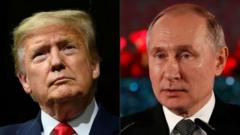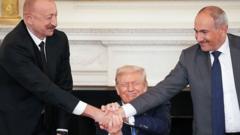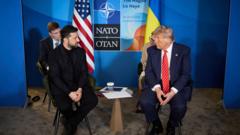In a significant policy shift, President Donald Trump has enacted sweeping new tariffs impacting more than 90 nations, a strategy aimed at rejuvenating American manufacturing and job growth. As of now, these tariffs are intended to bolster the U.S. economy, with Trump touting billions in revenue flowing into the country from these import taxes. On his Truth Social platform, Trump emphasized his administration's attempts to rectify perceived trade injustices, a key pledge during his return to the White House in January.
Trump's Bold Tariff Moves Reshape Global Trade Dynamics

Trump's Bold Tariff Moves Reshape Global Trade Dynamics
Donald Trump's latest tariffs affect over 90 countries, heightening trade tensions and driving U.S. economic goals.
These tariffs, announced in April but delayed due to market volatility and ongoing negotiation efforts, come with varied rates depending on the country, many of which have now reached their expiration. For instance, imposing tariffs of 40% on countries like Laos and Myanmar, often linked with trade ties to China, underscores the strategic nature of Trump's approach. While these measures have elicited trepidation about potential economic fallout globally, markets in Asia responded relatively calmly, showcasing marginal gains in major indexes.
In conjunction with the tariff implementations, Trump has prompted notable threats aimed at specific nations, particularly India, which faces a proposed increase to a 50% tariff on imports unless it ceases oil procurement from Russia. Furthermore, a staggering 100% tariff on foreign-made semiconductors has been threatened, compelling companies like Apple to ramp up domestic investments.
The backdrop of these tariffs is interspersed with ongoing international relations efforts, particularly in light of the conflict in Ukraine. Trump has indicated potential secondary tariffs targeting Moscow's trading partners if peace talks with Ukraine fail. The moves against India have received backlash, with officials labeling them as "unfair" while vowing to defend national interests.
Assembling a patchwork of agreements with varied countries has altered tariff specifics—a notable deal with the EU imposing a 15% rate and collaborative initiatives with Japan and South Korea that lower their prospective tariffs. Yet, trade experts caution that such swift tariff changes may impose heavier burdens on consumers and trigger retaliatory measures from affected countries. Overall, Trump's updated policies encapsulate his vision of a transformed global trading landscape that prioritizes American economic resilience.
In conjunction with the tariff implementations, Trump has prompted notable threats aimed at specific nations, particularly India, which faces a proposed increase to a 50% tariff on imports unless it ceases oil procurement from Russia. Furthermore, a staggering 100% tariff on foreign-made semiconductors has been threatened, compelling companies like Apple to ramp up domestic investments.
The backdrop of these tariffs is interspersed with ongoing international relations efforts, particularly in light of the conflict in Ukraine. Trump has indicated potential secondary tariffs targeting Moscow's trading partners if peace talks with Ukraine fail. The moves against India have received backlash, with officials labeling them as "unfair" while vowing to defend national interests.
Assembling a patchwork of agreements with varied countries has altered tariff specifics—a notable deal with the EU imposing a 15% rate and collaborative initiatives with Japan and South Korea that lower their prospective tariffs. Yet, trade experts caution that such swift tariff changes may impose heavier burdens on consumers and trigger retaliatory measures from affected countries. Overall, Trump's updated policies encapsulate his vision of a transformed global trading landscape that prioritizes American economic resilience.



















